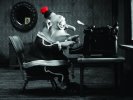Eye For Film >> Movies >> Mary And Max (2009) Film Review
There's something wonderfully tactile about stop-motion animation, from Creature Comforts to The Corpse Bride, the slightly rough around the edges look lends the characters a level of authenticity and, despite their obvious caricature, humanity that more glossy CGI offerings simply fail to match.
In Mary And Max - Oscar-winning animator Adam Elliot's first full-length feature - the claymation is coupled with exquisite attention to detail that creates not only a complex portrait of each of the main characters but also a vivid sense of place.

Mary could be a long-lost cousin of the Peanuts gang. Eight years old and with a dubious home life in Melbourne, her dad works a machine that stitches string into tea bags, and stuffs birds in his shed after hours, while mum spends her time, smoking, baking and "testing" sherry.
Mary finds cold comfort in animated TV show The Noblets, making imitation characters out of anything she can find, and in her pet rooster, Ethel. Lonely and picked on at school because she has a birthmark in the middle of her forehead that is "the colour of poo", one day, on a whim she rips a random name out of an American address book in the local post office and writes to a man named Max, in New York.
Max - a 44-year-old overeater who has Asperger's Syndrome - is about as far from Mary as it is possible to be in every respect and yet, through a love of The Noblets, chocolate and their unique take on the world an enduring pen-friendship is born. The description of the plot is apt to make it sound saccharine, seedy or both, but, in fact, this is a touching, acidly-witty look at loneliness, the comfort of strangers and the ignorance of society, realised with some of the best animation you're likely to see for quite some time.
Max's world, like his life, is monochrome, brightened only by the splashes of colour in the gifts Mary sends him. People don't understand him, call him mentally retarded, so he more or less keeps himself to himself, surrounded by a menagerie of animals, including a one-eyed cat called Hal ("It's short for halitosis, which he has," writes Max) and a succession of goldfish called Henry. Mary's world, meanwhile is, like her birthmark, made up of shades of brown from the poo end of the spectrum.
The voice cast are uniformly excellent, with Philip Seymour Hoffman almost unrecognisable as Max and Barry Humphries leaving Dame Edna at home to provide top-class narration. Although much is being made of Toni Collette as the voice of Mary, special mention must go to Bethany Whitmore, who voices her as a girl and who really sells her character to the audience.
Darker than Wallace And Gromit and more complex than Tim Burton's animations, this is one of those rare animated films which is aimed, not at children, but at discerning adults - although, it wouldn't hurt a youngster to watch it since doubtless most of the more adult references (dogs rutting, for example) would pass over their heads. The animation is jaw-droppingly good. Unlike Nick Park's characters, which rely on almost continual facial movement to make them 'live', Elliot employs his changing expressions sparingly, so that when they come they hold more impact - a smile becomes an emotional sunrise, a break out of sweat prompts a real feeling of anxiety.
The use of light and shadow is also slick and gives everything an added feeling of depth. Although on the surface a simple tale of friendship, the the film has layers of complexity which make it stand out. The characters' feelings run across the spectrum from unmitigated joy to the depths of depression and anxiety and they are complemented by the detailed animated world that surrounds them. Ethel the rooster is easily a comedy match for Shaun the sheep, while even the critters with the tiniest of bit parts - such as a super-speedy cockroach briefly seen in a cupboard - have oodles of character.
Elliot also proves a master when it comes to holding the narrative together amid the film's tonal shifts. There are many laugh out loud moments, so numerous and high quality it feels almost wrong to single out just one - although the death of a mime artist is particularly inspired - but there is also an unexpected depth to the friendship between Mary and Max. Elliot's characters go to some dark places and that he makes his audience laugh one minute and cry the next, without ever leaving them feeling emotionally manipulated, is a skilfull act.
Knowing how long it takes to make claymation - or "clayography" as the press notes term it - means that any undertaking such as this has got to be a labour of love; they managed to shoot just four seconds per day across a 57-week shoot for this particular film. That the story is based, loosely, on Elliot's own 20-year pen-palship with an Asperger's sufferer presumably makes it doubly important to make something special. But every scrap of effort pays off, with animation to die for and a script that's water-tight. It might cause a headache for marketeers, unsure how to pitch it to cinemas, but forget about them and their inability to cope with complexity. This is one friendship you want to be a part of.
Reviewed on: 16 Jan 2009
















